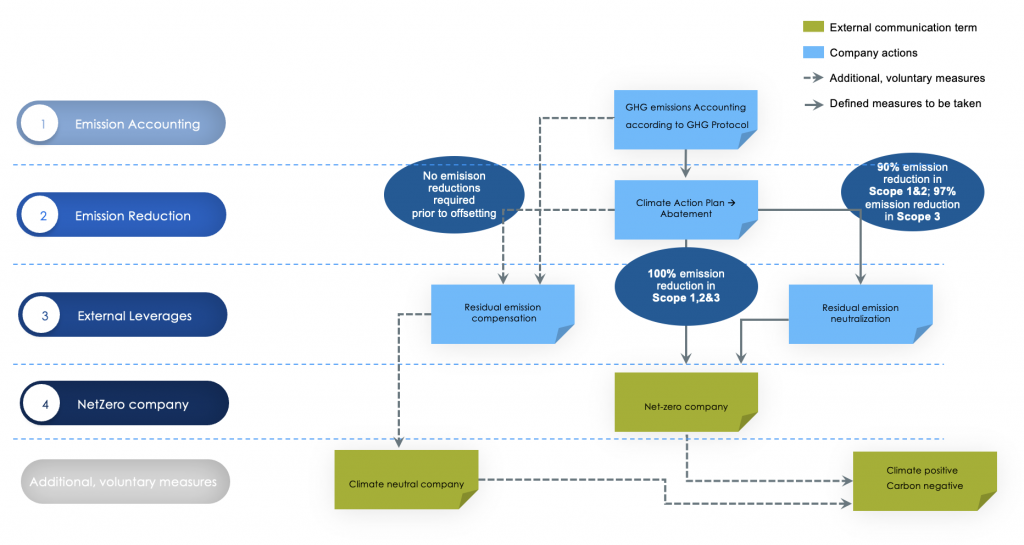During the last couple of years, the number of climate neutral claims for individual products or by entire organizations has risen drastically. Numerous of such claims faced legal complications and government regulations, as seen for instance in France. Companies have gone even further by claiming to become climate positive or carbon negative in the near future.
Along with the Science Based Target (SBT) update in October 2021 the SBT initiative implemented an additional term of a NetZero company.
The various yet similar terms may cause confusion about the intention of the different claims and how those claims can be understood.
Therefore, a clarification is needed that allows for a classification of those wordings. The terms we want to clarify are the following ones:
- Climate Neutral Company / Product
- CO2 Neutral Company / Product
- NetZero Company
- Climate Positive Company / Product
- Carbon Negative Company / Product
As a first step to claim any of the above listed statuses it is important to properly calculate the GHG emissions that are caused by a product or organization. This is typically done by applying the GHG Protocol or ISO Standards.
Once the emissions are calculated, companies should start reducing these emissions. However, to become a climate neutral company this is not a prerequisite. The calculated amount of emissions can be offset by purchasing the equivalent amount of emission certificates, independently of emission reduction efforts. For one ton of emissions caused, one emission certificate must be purchased in order to become a climate neutral company. This process is called compensation. Compensation can be achieved through carbon avoidance (i.e. production of green energy through solar or wind parks) or carbon removals (i.e. Direct Air Capture (DAC) with geological storage and nature-based solutions, i.e. reforestation). In this regard, the term CO2 neutral can be used interchangeably although from a scientific standpoint it implies not to take into account other relevant greenhouse gases apart from CO2. Both terms can also be used for product declaration.
The compensation can be seen as very pragmatic since companies are not ultimately required to reduce their emissions. That is possible since for the time being, there exists no widely adopted standard that would clearly define what climate neutrality comprises. The PAS2060 standard is the single standard that allows for an audit by external parties when it comes to climate neutrality claims. The standard asks for reduction measures in order to verify the respective company and / or product as climate neutral. Many climate neutral claims, however, are not based on the standard and simply rely on the fact that the amount of purchased climate certificates equals the calculated emissions in the respective GHG emission balance. However, the triad of reduction, avoidance and finally compensation is seen as best practice and should be adopted by companies.
Being aware of the problem described above, the Science Based Target initiative introduced its NetZero standard in late 2021. It requires companies to first reduce their emissions by at least 90% in Scope 1 and Scope 2, as well as up to 97% in Scope 3 while compensation measures are not counted towards the target fulfillment. Once companies reach the defined reduction thresholds, they are allowed to neutralize their residual emissions (around 10% of the overall emissions determined in the base year). Neutralization can only be achieved through carbon removals. Unlike the concept of climate neutrality, carbon avoidance does not count towards achieving the target of becoming a NetZero company.
The terms climate positive and carbon negative can be used interchangeably as they refer to the same activities. They mean that an activity goes beyond the NetZero or climate neutral status by removing and / or avoiding more emissions than the company / product produces.
The following graphics illustrates the different paths and outcomes that lead to the discussed statuses.

If you need support in identifying the best way to handle the different climate statuses and how those claims match with your overall climate strategy, feel free to contact us at or via phone +49 8192 99733-20.
We can help you in aligning your corporate and / or product representation with the underlying standards and stakeholder requirements and expectations to set up a long-term strategy that avoids greenwashing allegations.
Sources zu NetZero:
Government regulations on climate neutrality in France:
https://www.legifrance.gouv.fr/download/pdf?id=x7Gc7Ys-Z3hzgxO5KgI0zSu1fmt64dDetDQxhvJZNMc=
https://www.ademe.fr/sites/default/files/assets/documents/avis-ademe-neutralite-carbone-2021.pdf
http://www.arnaudgossement.com/archive/2021/05/06/greenwashing-focus-sur-les-dispositions-relatives-a-l-ecobl-6314273.html
http://www.arnaudgossement.com/archive/2021/05/22/neutre-en-carbone-une-publicite-bientot-interdite-loi-clima-6317458.html
Microsoft, information of becoming carbon negative:
https://blogs.microsoft.com/blog/2020/01/16/microsoft-will-be-carbon-negative-by-2030/
IKEA, information of becoming climate positive
https://about.ikea.com/en/sustainability/becoming-climate-positive
Science Based Target Initiative:
https://sciencebasedtargets.org/news/sbti-launches-world-first-net-zero-corporate-standard
PAS2060:









